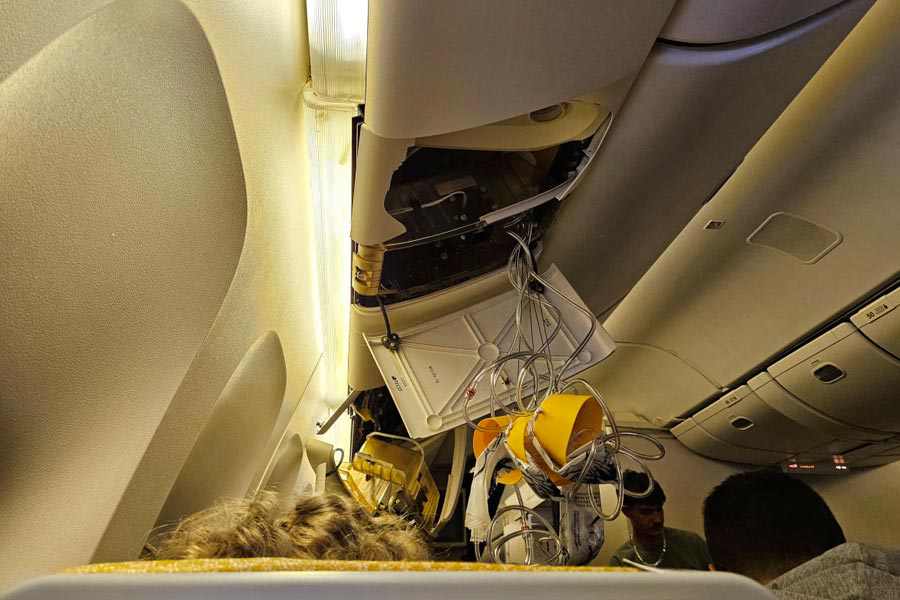The extreme turbulence on Singapore Airlines (SIA) flight SQ321 – which left one passenger dead from a suspected heart attack and dozens injured – has inflicted psychological scars on those who survived, it emerged on Sunday.
One passenger, describing the ordeal as “quite scary”, declared that he may not fly again for a while. Another said he threw up after waking up on the plane floor, following the turbulence, to the sound of people crying and the sight of blood, The Straits Times newspaper reported.
The aircraft, which left London’s Heathrow Airport for Singapore on May 21, experienced extreme turbulence for 62 seconds over the Irrawaddy Basin around 10 hours after departure. It was then diverted to Thailand’s Suvarnabhumi Airport for an emergency landing.
The pilot diverted the plane carrying 211 passengers and 18 crew members to Bangkok’s Suvarnabhumi Airport after declaring a medical emergency, before making an emergency landing at 3:45 pm.
Mental health professional Amanda Oh, founder of Budding Space, said a traumatic experience can make it difficult for a person to understand or process a situation, much like “an indigestion in the mind”.
“For such a unique experience as what the passengers had to go through, it would be an extremely overwhelming experience for anybody,” the broadsheet quoted Dr Oh as saying. This could cause psychological pain and physiological distress.
Those who were on board the flight could experience mental health issues, including acute stress disorder (ASD), post-traumatic stress disorder (PTSD) and anxiety disorders.
The passengers on SQ321 included 41 Singaporeans, with the remaining 170 from countries such as Australia, India, Malaysia, New Zealand and Britain.
The dead passenger has been identified as a 73-year-old Briton, Geoff Kitchen. He was a retired insurance professional and musical theatre director at the time of his death, according to British media reports.
A total of 41 passengers remain hospitalised across three hospitals in Bangkok, according to the latest update from Samitivej Srinakarin Hospital on Sunday.
Dr Annabelle Chow – the principal clinical psychologist at Annabelle Psychology – said that up to a month after the incident, those affected may experience ASD, which includes symptoms such as recurrent and involuntary flashbacks, appetite and sleep changes, as well as memory gaps.
However, they may be diagnosed with PTSD instead if symptoms persist past the one-month mark. PTSD has been known to affect a person’s social functioning and physical well-being, said Dr Chow.
One may also develop an anxiety disorder, and experience panic attacks and physiological responses like a rapid heartbeat, sweating and nausea.
Dr Oh pointed out that the incident could also have been “vicariously traumatic” for the loved ones of those on board SQ321, who could develop similar reactions despite not having been on the plane.
She gave reassurance, however, that with adequate support, “trauma’s impact on the brain is reversible”.
To increase their feelings of perceived safety, passengers should maintain a healthy lifestyle and take part in activities involving bilateral stimulation like walking and swimming, which would help the mind process the traumatic experience better, said Dr Oh.
Family members can also play their part by being accommodating during this period of time.
“For example, if (the traumatised individuals) want to cry or talk about it, let them do that. Let them choose their way to grieve and process the experience in a way that they are comfortable with rather than hurrying them along that journey,” said Dr Oh, stressing that a sense of autonomy and control would improve their sense of perceived safety.
Dr Thomas Lee, medical director at Resilienz clinic, recommended eye movement desensitisation and reprocessing (EMDR) – a popular method in trauma therapy.
He said that the treatment, done by a trained specialist, could help reduce the impact of the traumatic memory.
Compared to the passengers, the cabin crew may experience a worse impact on their mental health, according to the Singapore daily report.
“You may think that they are used to turbulence but this is a bad case,” said Dr Lee, adding that it would be good if early intervention counselling is provided to the cabin crew.
All the three experts, while hopeful that recovery is possible, agreed that the duration will depend on the individual.
Based on his experience, said Dr Lee, recovery could take months or even years.
The amount of distress felt by an individual during the flight – determined by factors such as whether they were hit by an object during the turbulence – would also influence the recovery time, said Dr Chow.
Recovery could also be drawn out if the patient has other unresolved traumas, Dr Oh noted.
If the individual has previous unresolved traumas such as abuse, the SQ321 experience would trigger those other unresolved traumas, she added.
“They would likely require a longer recovery time simply because they would be uncovering all these other unresolved traumas,” said Dr Oh.
She stressed, however, that increasing the sense of perceived safety would ultimately be helpful for those who are directly or indirectly traumatised by the turbulence on SQ321.
Meanwhile, the turbulence-hit SIA plane returned to Singapore on Sunday after being cleared for departure from Bangkok.
Except for the headline, this story has not been edited by The Telegraph Online staff and has been published from a syndicated feed.











